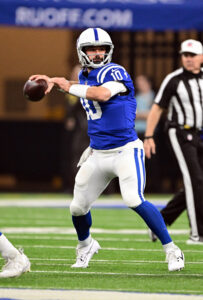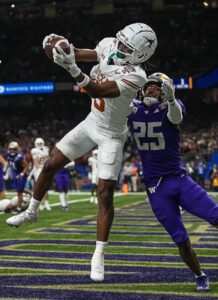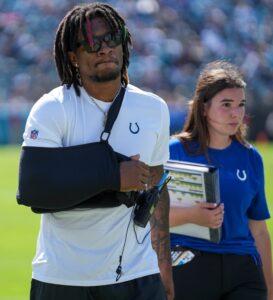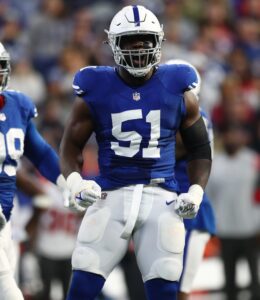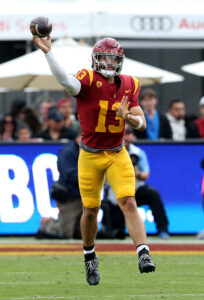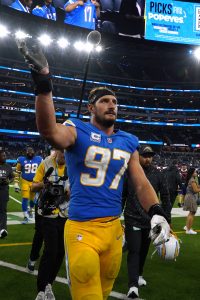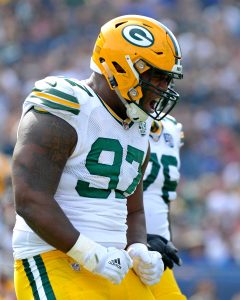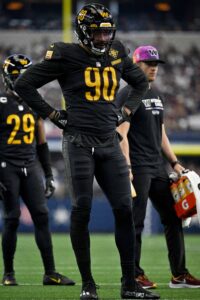The Colts nearly turned a seemingly lost season into a playoff berth, falling just short of an AFC South title despite Gardner Minshew needing to replace Anthony Richardson early. Indianapolis responded to its 9-8 showing by displaying tremendous confidence in Chris Ballard‘s homegrown core, one that has largely been around as the team has cycled through post-Andrew Luck quarterback options. A spree of extensions and re-signings defined Indy’s offseason; well, that and Richardson’s rehab effort.
While last season marked a surprise surge, it also still brought few answers on the gamble the team took at No. 4 overall. Richardson entered the NFL as a raw prospect with tantalizing tools; his run of injuries last year brought obvious concerns. More importantly, the Florida product threw 84 passes after a 393-pass Gators career. The Colts need the dual-threat QB to show signs he will be the long-awaited post-Luck long-term QB. Some of Luck’s teammates are still in the picture in Indy, illustrating how far back Ballard’s core goes. The team continued its build-from-within strategy this offseason.
Extensions and restructures:
- Gave DT DeForest Buckner two-year, $46MM extension ($43.25MM guaranteed)
- Extended franchise-tagged WR Michael Pittman Jr. at three years, $70MM ($41MM guaranteed)
- Handed LB Zaire Franklin four-year, $31.26MM extension ($17.62MM guaranteed)
As injuries caught up with T.Y. Hilton, Pittman quickly became the Colts’ lead wideout. The 2020 second-rounder had operated as such for most of his career, and while the Colts resolved the Jonathan Taylor matter before taking care of Pittman, the franchise tag made a rare appearance in Indianapolis to ensure the two-time 1,000-yard receiver could not test the market. Using the tag for the first time since cuffing Pat McAfee in 2013, the Colts slapped a $21.8MM tender on Pittman. Unlike the Bengals, who are renting Tee Higgins for at least one more season, Pittman — chosen one spot after Higgins in the 2020 second round — signed an extension just before the legal tampering period opened.
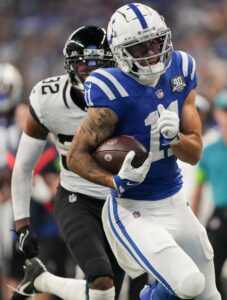 Pittman’s extension moved the $21.8MM number off the Colts’ books, freeing them up to execute a retention-heavy free agency strategy. The Colts also did well, as it turned out, by not letting negotiations drag near the July 15 deadline.
Pittman’s extension moved the $21.8MM number off the Colts’ books, freeing them up to execute a retention-heavy free agency strategy. The Colts also did well, as it turned out, by not letting negotiations drag near the July 15 deadline.
Indy extending Pittman on March 11 came just before Calvin Ridley scored a four-year, $92MM deal ($46.98MM fully guaranteed) and weeks before Amon-Ra St. Brown‘s extension confirmed another market boom was coming. Pittman, 26, was not a candidate to rival A.J. Brown and Justin Jefferson‘s $32MM- and $35MM-per-year extensions, but the fifth-year Colt would have benefited by the WR ceiling rising had those transactions occurred before his.
The Colts convincing Pittman, shortly after news of the cap’s $30.6MM spike emerged, to do a deal south of where 2022 extension recipients Deebo Samuel and D.K. Metcalf reside proved a win for the team. Following the St. Brown and Jefferson pacts, along with Nico Collins‘ $24MM-per-year deal, Pittman sits as the NFL’s 14th-highest-paid wideout. CeeDee Lamb and Brandon Aiyuk figure to affect that placement soon, but via the short-term extension, Pittman should have a chance at another big payday in his late 20s.
Richardson’s injury probably helped Pittman contractually. The raw rookie likely would not have been able to set up Pittman for the season he had — 109 catches, 1,152 yards — but Minshew peppered the 6-foot-4 weapon with targets to help the Colts’ surprising run to the postseason precipice. The Colts strengthened their receiving corps in the draft, but Richardson will be looking Pittman’s way first as the team enters its second season under Shane Steichen.
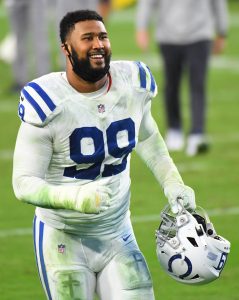 After Indianapolis’ binge of agreements with homegrown talent, Ballard extended the D-line centerpiece he acquired via trade four years ago. Obtained for a 2020 first-round pick, Buckner has remained one of the NFL’s best defensive tackles. While the 49ers cut Arik Armstead four years after choosing his slightly cheaper extension over a Buckner re-up back in 2020, the latter is still going strong in Indiana.
After Indianapolis’ binge of agreements with homegrown talent, Ballard extended the D-line centerpiece he acquired via trade four years ago. Obtained for a 2020 first-round pick, Buckner has remained one of the NFL’s best defensive tackles. While the 49ers cut Arik Armstead four years after choosing his slightly cheaper extension over a Buckner re-up back in 2020, the latter is still going strong in Indiana.
Buckner, 30, scored a deal that comes nearly fully guaranteed. He moved from $21MM per year to $23MM on average, and while his current AAV sits seventh among DTs, the former top-10 pick traded a push for a top-market salary for security. Buckner’s 2024 and ’25 base salaries are fully guaranteed, and the Colts have the Oregon alum on the books through his age-32 season.
A two-time Pro Bowler as a Colt — in addition to receiving a 2020 first-team All-Pro nod — Buckner has missed one game since being traded. The Colts will hope to continue to rely on a player who has anchored their D-line during a period of edge rusher uncertainty. Buckner’s presence boosted the development of Kwity Paye and Dayo Odeyingbo, both of whom making progress en route to career-high sack totals last season. Buckner’s four-year Colts sack count (32.5) betters his four-season 49ers work (28.5), and his 87 QB hits with the AFC team outflank his San Francisco total as well.
Totaling between seven and 9.5 sacks during his Colts tenure, Buckner gives the team a high floor that will certainly be important as the team attempts to load up around Richardson. Pro Football Focus has slotted Buckner as a top-12 DT in three of his four Indy seasons, and ESPN’s pass rush win rate metric tabbed him fifth among interior D-linemen last season. This near-fully guaranteed contract shows one of the luxuries a rookie-scale QB provides for a franchise.
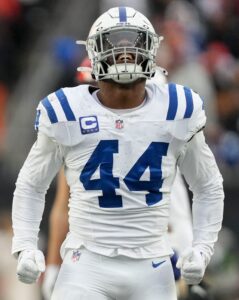 As Shaquille Leonard‘s injuries mounted to the point the perennial All-Pro became a late-season release last year, the Colts leaned on Franklin. The latter’s latest agreement came two years after the Colts had re-signed the former seventh-rounder to a three-year, $10MM deal. A Syracuse product, Franklin adds to Ballard’s breakthrough 2018 draft haul. The ’18 group played a key role in the Colts reigniting after a miserable Andrew Luck-less 2017, with Leonard, Quenton Nelson, Braden Smith, Nyheim Hines and Tyquan Lewis going off the board before Franklin.
As Shaquille Leonard‘s injuries mounted to the point the perennial All-Pro became a late-season release last year, the Colts leaned on Franklin. The latter’s latest agreement came two years after the Colts had re-signed the former seventh-rounder to a three-year, $10MM deal. A Syracuse product, Franklin adds to Ballard’s breakthrough 2018 draft haul. The ’18 group played a key role in the Colts reigniting after a miserable Andrew Luck-less 2017, with Leonard, Quenton Nelson, Braden Smith, Nyheim Hines and Tyquan Lewis going off the board before Franklin.
Amid Leonard’s run of 2022 misfortune, Franklin moved into a full-time role and racked up 167 tackles alongside Bobby Okereke. The Colts depended on Franklin more last season, with Okereke defecting to the Giants. Franklin compiled 179 tackles in a three-down role. He has forced four fumbles over the past two seasons. Although PFF slotted Franklin 58th among off-ball LBs in each of those years, the Colts authorized a significant raise to continue as a regular in Gus Bradley‘s defense.
Re-signings:
- Grover Stewart, DT. Three years, $39MM ($17.99MM guaranteed)
- Kenny Moore, CB. Three years, $30MM ($16MM guaranteed)
- Tyquan Lewis, DL. Two years, $12MM ($6.7MM guaranteed)
- Julian Blackmon, S. One year, $3.7MM ($3.19MM guaranteed)
- Rigoberto Sanchez, P. Three years, $7.5MM ($2.5MM guaranteed)
- Taven Bryan, DT. One year, $2MM ($1.13MM guaranteed)
- Danny Pinter, OL. One year, $1.22MM ($500K guaranteed)
- Ronnie Harrison, S/LB. One year, $1.29MM ($168K guaranteed)
- Genard Avery, DE. One year, $1.13MM
- Trey Sermon, RB. One year, $1.1MM
Of the Colts’ 22 projected offensive and defensive starters, 19 are homegrown. Moore practically pushes that number to 20, having been a Colts waiver claim (from the Patriots) ahead of his 2017 rookie season. That doubled as Ballard’s first offseason. Despite the Colts having one playoff berth since Luck’s surprise 2019 retirement, the Moore and Stewart efforts quickly showed how Ballard planned to supplement Richardson’s contract.
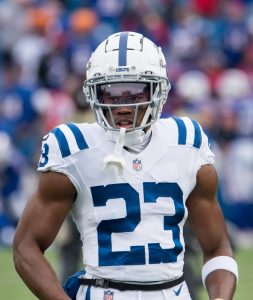 The money largely went to in-house additions, with Moore being the most significant of the re-signed contingent. For the second time, a Moore agreement raised the ceiling for slot defenders. The Colts took care of Moore when he was first extension-eligible, back in 2019. Although the former UDFA played out the deal, he has remained in form good enough to prompt another investment. Considering the uncertainty surrounding the Colts’ boundary cornerback spots, Moore locking down the slot is paramount to the team’s defensive effectiveness.
The money largely went to in-house additions, with Moore being the most significant of the re-signed contingent. For the second time, a Moore agreement raised the ceiling for slot defenders. The Colts took care of Moore when he was first extension-eligible, back in 2019. Although the former UDFA played out the deal, he has remained in form good enough to prompt another investment. Considering the uncertainty surrounding the Colts’ boundary cornerback spots, Moore locking down the slot is paramount to the team’s defensive effectiveness.
Moore, who will turn 29 next month, made an effort to secure a new contract during the 2022 offseason. With two years remaining on the four-year, $33.3MM contract, Ballard and Co. did not hand out a new one following Moore’s 2021 Pro Bowl slate. Like Chris Harris before him, Moore has operated as a high-end slot stopper who wanted to be paid closer to perimeter standouts. After a down 2022, Moore bounced back with a three-INT season that included two pick-sixes. Indianapolis ranked third in defensive DVOA in the slot compared to 25th in outside coverage. Moore’s 13 INTs from the slot position are five more than any other player since 2017; PFF ranked the 5-9 cover man 18th among all corners last season.
Also included in the top 40 on PFR’s free agent list, Stewart joined Moore in securing better terms compared to his second Colts contract. The team gave the 2017 fourth-rounder a notable raise after his 2023 season brought a PED suspension. Stewart’s six-game absence showed against the run. The Colts allowed 107.9 rushing yards per game with Stewart suited up; during his six-game ban, Indianapolis yielded 153 on the ground. Stewart, 30, also registered a career-high four sacks in 2022. Other than the PED penalty, he has not missed a game since 2019.
 This offseason brought the first test for Ballard regarding third-contract investments; the Moore and Stewart accords showed no hesitancy existed on this front. Ballard has long prioritized homegrown talent, and these contracts show the longtime GM is willing to reward pillars approaching the end of their primes. The Colts will deploy two 30-year-old DT starters, though their DE core is much younger.
This offseason brought the first test for Ballard regarding third-contract investments; the Moore and Stewart accords showed no hesitancy existed on this front. Ballard has long prioritized homegrown talent, and these contracts show the longtime GM is willing to reward pillars approaching the end of their primes. The Colts will deploy two 30-year-old DT starters, though their DE core is much younger.
It took some time for Blackmon to come back, and the former second-round pick was not too pleased with his market. The four-year Colts starter visited the Bills and 49ers before agreeing to re-sign — likely to bolster his value for a 2025 free agency redux. Blackmon, 26 in August, was part of a safety market that rewarded high-level young talent (Antoine Winfield Jr., Xavier McKinney, Kyle Dugger) but cast other proven players (Justin Simmons, Quandre Diggs, Eddie Jackson, Jamal Adams, Kevin Byard) aside. Kamren Curl also settled for a low-level Rams deal, and it is far from certain a solid Blackmon season will lead to a value spike as macro safety assessments fluctuate.
A middle tier did form in free agency, with C.J. Gardner-Johnson (three years, $27MM), Brandon Jones (3/20) and Geno Stone (2/12) cashing in this year. Blackmon could aim for this tier in 2025, though he was already coming off a decent contract year. The Utah alum intercepted four passes, deflected eight more and recovered two fumbles in 2023, as Bradley used the versatile safety across the formation. More of the same should be expected, as Blackmon has helped cover for 2022 third-rounder Nick Cross being unable — through two years, at least — to establish himself as a reliable starter.
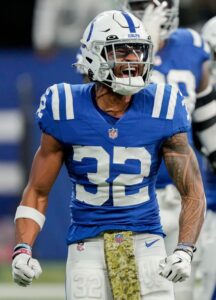 During Blackmon’s time in free agency, the Colts hosted Kareem Jackson and showed interest in former Buccaneers and Chiefs option Mike Edwards. The duo having not previously played with the Colts clearly hurt his chances during one of the NFL’s most inward-focused offseasons in recent memory. Lewis also benefited from this approach, inking a fourth Indianapolis contract, with Sanchez also now tied to a third Colts accord. Sanchez, 29, recovered from a season-nullifying injury sustained just before the 2022 campaign. After a 17-game 2023, the former UDFA is back for an eighth season in Indianapolis.
During Blackmon’s time in free agency, the Colts hosted Kareem Jackson and showed interest in former Buccaneers and Chiefs option Mike Edwards. The duo having not previously played with the Colts clearly hurt his chances during one of the NFL’s most inward-focused offseasons in recent memory. Lewis also benefited from this approach, inking a fourth Indianapolis contract, with Sanchez also now tied to a third Colts accord. Sanchez, 29, recovered from a season-nullifying injury sustained just before the 2022 campaign. After a 17-game 2023, the former UDFA is back for an eighth season in Indianapolis.
Settling in as a rotational backup capable of playing inside and outside, Lewis matched his career-high with four sacks in 2023 and established a new mark for QB hits with 13. The Colts racked up 51 sacks last season, good enough for fifth in the NFL. While Buckner, Paye, Odeyingbo and Samson Ebukam led the effort by each collecting at least seven, Lewis managed to recover from a second patellar tendon tear in two years. The former second-round pick suited up for all 17 games and scored some guaranteed money as a result, keeping Indy’s D-line core together for 2024.
Free agency additions:
- Raekwon Davis, DT. Two years, $14MM ($6MM guaranteed)
- Joe Flacco, QB. One year, $4.5MM ($4.5MM guaranteed)
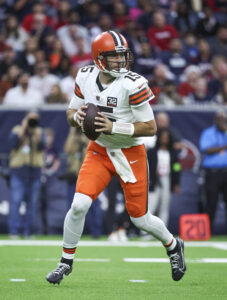 This is quite the run for Flacco, who has gone from receiving next to no interest as a 2023 free agent to the NFL’s Comeback Player of the Year to securing the most guaranteed money he has received since his final Ravens deal ended with a Broncos release. Flacco, who has banked $177MM over his career to make him a top-10 earner in NFL history, has not signed for more than $3.5MM since inking his second and final Ravens extension in 2016. Five regular-season Browns starts and a forgettable playoff outing generated interest, as the Colts needed a new backup after Minshew joined Flacco in boosting his market last season.
This is quite the run for Flacco, who has gone from receiving next to no interest as a 2023 free agent to the NFL’s Comeback Player of the Year to securing the most guaranteed money he has received since his final Ravens deal ended with a Broncos release. Flacco, who has banked $177MM over his career to make him a top-10 earner in NFL history, has not signed for more than $3.5MM since inking his second and final Ravens extension in 2016. Five regular-season Browns starts and a forgettable playoff outing generated interest, as the Colts needed a new backup after Minshew joined Flacco in boosting his market last season.
Joining the Browns after Deshaun Watson needed season-ending surgery, Flacco fared far better than he had as a Jet. The former Super Bowl MVP, who initially caught on with Cleveland via a practice squad deal, averaged 7.9 yards per attempt and threw 13 TD passes (and eight INTs) in five games — a stretch that included wins over the Texans, Jaguars and Jets. This came despite the Browns missing their starting tackles and Nick Chubb. Flacco posted four straight 300-yard showings in the Cleveland wins, driving the team to an 11-6 record and a postseason berth. Although Flacco topped 300 yards again in the wild-card round, his two pick-sixes ended the unexpected surge.
At 39, Flacco is the NFL’s second-oldest quarterback (behind Aaron Rodgers). He also expected the Browns to show interest, but Cleveland — as it shifts to a more Watson-friendly offense — preferred ex-Indianapolis FA target Jameis Winston. The Eagles also made Flacco an offer for what would have been a Philly return trip. This Colts move comes with clear risk, given Flacco’s struggles in the four seasons between his Baltimore stay and the Cleveland rebound, as Richardson came out of multiple games due to injury last season.

